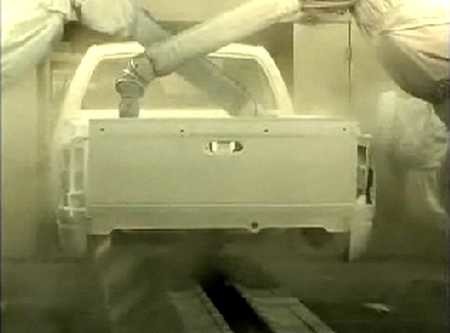
One of the inevitable results of painting the body of a new vehicle is overspray. Ensuring that the entire body is painted means some of the paint will miss. All modern paint shops use waterborne paints so the paint that falls doesn't land on the metal can be collected and the water removed. The problem then becomes a solid material that has to be disposed of. At Chrysler's two St. Louis assembly plants that produce Ram pickups and minivans, about a million pounds of paint solids are created as a byproduct each year. This waste used to go to a landfill.
For the past year and a half those plants have been trucking the paint solids to a nearby coal-fired power plant. The solids are blended with coal and burned to produce electricity, displacing about 570 tons of coal annually. A side benefit is that during burning the titianium dioxide in the paint solids reduces the mercury emitted from the coal. There's a Chrysler video after the jump.
[Source: Chrysler]
The video meant to be presented here is no longer available. Sorry for the inconvenience.
Chrysler's St. Louis Assembly Plants, Utility Company In Second Year of Unique Program to Convert Paint to Power
• Overspray from painting Chrysler minivans and pickups becomes fuel in nearby electric-generating plant
• Program saves landfill space, provides electricity to 70 homes for a year
• Added Benefit :Paint solids may reduce mercury emissions from power plant
St. Louis, Missouri, Feb 28, 2008 - Chrysler LLC and the St, Louis-based utility company AmerenUE are midway through their second year of a unique partnership to turn paint solids left over from automobile production into electricity for Missouri homes and businesses.
Since September 2006, Chrysler's St. Louis Assembly Plants, which build minivans and pickup trucks, have recycled paint solid overspray from their operations for use as an alternative fuel in Ameren's nearby Meramec 855-megawatt electric utility plant.
Prior to this project, Chrysler's St. Louis plants were sending one million pounds of dried paint solids to landfill each year. Now, the paint solids replace about 570 tons of coal per year in the Ameren plant, enough to power 70 homes for a year.
The collaboration is the first in the nation to generate electricity by burning paint solids recovered from an automotive manufacturing facility.
The project may have another benefit: titanium dioxide contained in many of the paints used at the Chrysler plants may reduce emissions of mercury when burned in coal-fired electric power plants.
The effectiveness of titanium dioxide in controlling mercury emissions has been demonstrated in the laboratory and recent field studies, according to Dr. Pratim Biswas of Washington University in St. Louis. Biswas is heading up a full-scale test of the process in collaboration with Chrysler and Ameren.
"This project is a win all the way around - for us, for Ameren and for the environment," said Charles Kowalski, Manager of Chrysler's St. Louis North Assembly Plant.
Two truckloads of de-watered paint solids are sent to the Ameren facility each week, where they are mixed with coal for burning in the utility plant's electric-generating processes.
St. Louis-based Ameren Corporation and its subsidiaries serve 2.4 million electric customers in Missouri and Illinois.


Sign in to post
Please sign in to leave a comment.
Continue